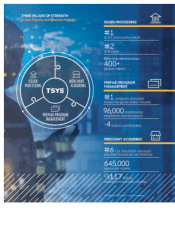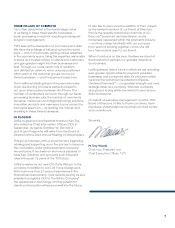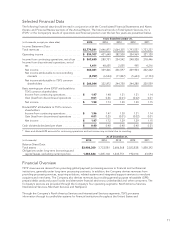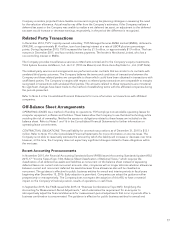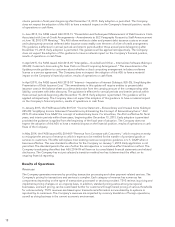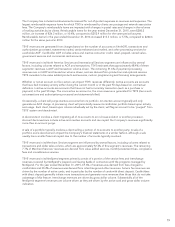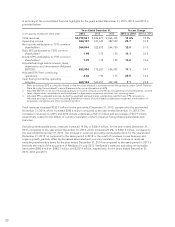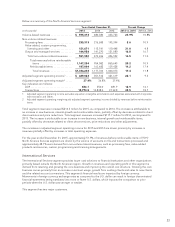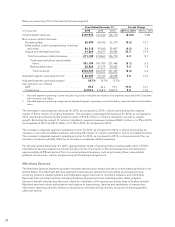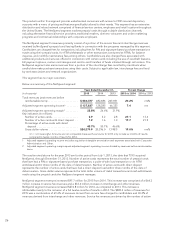NetSpend 2015 Annual Report Download - page 20
Download and view the complete annual report
Please find page 20 of the 2015 NetSpend annual report below. You can navigate through the pages in the report by either clicking on the pages listed below, or by using the keyword search tool below to find specific information within the annual report.
customer arrangement. There were no material changes or impact to revenue in revenue recognition in the year
ended December 31, 2015 due to any changes in the determination of the number of deliverables in an
arrangement, units of accounting, or estimates of VSOE or ESP for existing contractual arrangements.
Cardholders’ Reserve
The Company is exposed to losses due to cardholder fraud, payment defaults and other forms of cardholder
activity as well as losses due to non-performance of third parties who receive cardholder funds for transmittal to
the Issuing Banks (banks that issue MasterCard International or Visa USA, Inc. branded cards to customers). The
Company establishes a reserve for the losses it estimates will arise from processing customer transactions, debit
card overdrafts, chargebacks for unauthorized card use and merchant-related chargebacks due to non-delivery of
goods or services. These reserves are established based upon historical loss and recovery rates and cardholder
activity for which specific losses can be identified. The cardholders’ reserve was $9.4 million as of December 31,
2015. The provision for cardholder losses is included in cost of services in the Consolidated Statements of
Income. The Company regularly updates its estimate as new facts become known and events occur that may
impact the settlement or recovery of losses.
Provision for Merchant Losses
The Company has potential liability for losses resulting from disputes between a cardholder and a merchant that
arise as a result of, among other things, the cardholder’s dissatisfaction with merchandise quality or merchant
services. Such disputes may not be resolved in the merchant’s favor. In these cases, the transaction is “charged
back” to the merchant, which means the purchase price is refunded to the customer by the card-issuing bank and
charged to the merchant. If the merchant is unable to fund the refund, TSYS must do so. TSYS also bears the risk
of reject losses arising from the fact that TSYS collects fees from its merchants on the first day after the monthly
billing period. If the merchant has gone out of business during such period, TSYS may be unable to collect such
fees. TSYS maintains cash deposits or requires the pledge of a letter of credit from certain merchants, generally
those with higher average transaction size where the card is not present when the charge is made or the product
or service is delivered after the charge is made, in order to offset potential contingent liabilities such as
chargebacks and reject losses that would arise if the merchant went out of business. Most chargeback and reject
losses are charged to cost of services as they are incurred. However, the Company also maintains a provision
against losses, including major fraud losses, which are both less predictable and involve larger amounts. The loss
provision is established using historical loss rates, applied to recent bankcard processing volume. As of
December 31, 2015, the Company had a merchant loss provision in the amount of $1.3 million.
Transaction Processing Provisions
The Company records estimates to provide for contract contingencies (performance penalties) and processing
errors. A significant number of the Company’s contracts with large clients contain service level agreements which
can result in TSYS incurring performance penalties if contractually required service levels are not met. When
estimating these accruals, the Company takes into consideration such factors as the prior history of performance
penalties and processing errors incurred, actual contractual penalties inherent in the Company’s contracts,
progress towards milestones, and known processing errors not covered by insurance. If the actual performance
penalties incurred are not consistent with the Company’s estimates, performance penalties and processing errors,
which are recorded in cost of services, may be materially different than were initially recorded. The Company’s
experience and extensive data accumulated historically indicate that these estimates have proven reliable over
time. As of December 31, 2015, the Company had a transaction processing provision in the amount of $6.5
million.
Income Taxes
In calculating its effective tax rate, the Company makes decisions regarding certain tax positions, including the
timing and amount of deductions and allocations of income among various tax jurisdictions. The Company has
various tax filing positions, including the timing and amount of deductions and credits, the establishment of
reserves for audit matters and the allocation of income among various tax jurisdictions.
The Company makes estimates as to the amount of deferred tax assets and liabilities and records valuation
allowances to reduce its deferred tax assets to reflect the amount that is more likely than not to be realized. The
16


